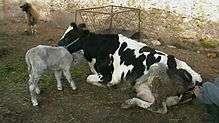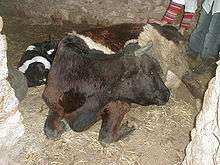Milk fever
Milk fever, postparturient hypocalcemia, or parturient paresis is a disease, primarily in dairy cattle, but also seen in beef cattle, characterized by reduced blood calcium levels (see: Hypocalcemia). It occurs following parturition, at onset of lactation, when demand for calcium for colostrum production exceeds the body’s ability to mobilize calcium.[1] “Fever” is a misnomer, as body temperature during the disease is generally not elevated. Milk fever is more commonly seen in older animals (which have reduced ability to mobilize calcium from bone) and in certain breeds (such as Channel Island breeds).[2]
Cause
The cause of milk fever was established by Prof John Russell Greig and Henry Dryerre at the Moredun Research Institute in Scotland.[3]
During the dry period (late gestation, non-lactating), dairy cattle have relatively low calcium requirements, with a need to replace approximately 30 g of calcium per day due to utilization for fetal growth and fecal and urinary losses. At parturition, the requirement for calcium is greatly increased due to initiation of lactation, when mammary drainage of calcium may exceed 50g per day.[2] Due to this large increase in demand for calcium, most cows will experience some degree of hypocalcemia for a short period following parturition as the metabolism adjusts to the increased demand. When the mammary drain of plasma calcium causes hypocalcemia severe enough to compromise neuromuscular function, the cow is considered to have clinical milk fever.[1]
Mechanism
In normal calcium regulation, a decrease in plasma calcium levels causes the parathyroid glands to secrete parathyroid hormone (PTH), which regulates the activation of Vitamin D3 in the kidney. These two compounds act to increase blood calcium levels by increasing absorption of dietary calcium from the intestine, increasing renal tubular reabsorption of calcium in the kidney, and increasing resorption of calcium from bones.[2]
It has been found that tissue is less responsive to parathyroid hormone prepartum, compared to postpartum. It is believed that hypocalcemia causing milk fever is due to a lower level of responsiveness of the cow's tissues to circulating parathyroid hormone.[1]
The resultant decreased plasma calcium causes hyperexcitability of the nervous system and weakened muscle contractions, which result in both tetany and paresis.[4]
Clinical signs


The clinical signs of milk fever can be divided into three distinct stages:
Stage 1: Cows are mobile but show signs of hypersensitivity and excitability such as restlessness, tremors, ear twitching, head bobbing and mild ataxia. If not treated, symptoms usually progress to stage 2.
Stage 2: Cows can no longer stand and present in sternal recumbency. Tachycardia, weakened heart contraction and peripheral pulses. Cows appear dull, have dry muzzles, cold extremities and a lower than normal body temperature. Smooth muscle paralysis can cause bloat, and the inability to urinate or defecate. Cows often tuck their heads into their flanks.
Stage 3: Lateral recumbency, muscle flaccidity, unresponsiveness to stimuli, and loss of consciousness progressing to coma. Heart rate can approach 120 bpm, with peripheral pulses becoming undetectable. If untreated, progression will continue to death.[4]
Treatment
Treatment generally involves calcium injection by intravenous, intramuscular or subcutaneous routes. Before calcium injection was employed, treatment comprised inflation of the udder using a pneumatic pump. Inflation of the udder worked because the increased pressure created in the udder pushed the calcium in the udder back into the bloodstream of the cow.[5]
Intravenous calcium, though indicated in many cases, is potentially fatal through “heart blockade”, or transient high calcium levels stopping the heart, so should be administered with care.
In unclear cases of downer cows, intravenous calcium injection can lead to diagnosis. The typical reaction will be a generalized tremor of the skeletal muscles, and sometimes cardiac arrhythmia. Defecation, urination and eructation are frequent during the treatment, due to pharmacological effect of calcium on the smooth muscles.
The prognosis is generally good, even in advanced cases. However, some cows can relapse the following day, and even a third time the day after.[6]
- Hypothermia (normal is 38,0-39,5 °C)
- Miction and defecation commonly occurring during calcium treatment
Prevention
Proper dietary management will prevent most cases of milk fever. This generally involves close attention to mineral and fiber levels in the diet prior to calving, as well as improving cow comfort to eliminate other problems that may interfere with appetite and so trigger hypocalcemia.
Oral administration of a dose of a calcium salt in a gel has been advised by some veterinarians.[7]
An orally administered bolus containing a much higher concentration of calcium than the injectable solutions can also be given so long as the cow is standing or sitting up. If the cow is lying 'flat out' then immediate intravenous therapy is required to avoid death.
References
- 1 2 3 Horst, R.L.; Goff, J.P.; Reinhardt, T.A.; Buxton, D.R. "Strategies for Preventing Milk Fever in Dairy Cattle". Journal of Dairy Science. 80 (7): 1269–1280. doi:10.3168/jds.s0022-0302(97)76056-9.
- 1 2 3 DeGaris, Peter J.; Lean, Ian J. (2008-04-01). "Milk fever in dairy cows: A review of pathophysiology and control principles". The Veterinary Journal. Special Issue: Production Diseases of the Transition Cow. 176 (1): 58–69. doi:10.1016/j.tvjl.2007.12.029.
- ↑ http://www.moredun.org.uk/webfm_send/579
- 1 2 "Parturient Paresis in Cows: Disorders of Calcium Metabolism: Merck Veterinary Manual". www.merckvetmanual.com. Retrieved 2015-11-06.
- ↑ Niedermeier, R.P.; Smith, Vearl R. (1950), "The Effect of Udder Inflation Upon Blood Levels of Calcium, Magnesium and Phospherous in Cows with Parturient Paresis", Journal of Dairy Science, 33: 38–42, doi:10.3168/jds.S0022-0302(50)91862-5
- ↑ Lucien Mahin (1977–2008), Observations on diseases of cattle in Morocco (unpublished data)
- ↑ Haalstra, R.T. (1973), Tijdchrift voor Diergeneeskunde, 98, p. 529
External links
- Prevention of Milk Fever, University of Kentucky
- Parturient Paresis in Cows (Milk fever, Hypocalcemia), The Merck Veterinary Manual
| Wikimedia Commons has media related to Hypocalcemia in ruminants. |